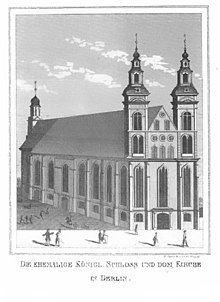Dominican monastery in Cölln

The Dominican monastery Cölln was a monastery of the Dominicans in the city Kölln , the sister city of Berlin . It belonged to the Teutonia province of the order. From 1536 onwards, Elector Joachim II expanded it into the Hohenzollern court and cathedral church.
History and building history
The monastery to the south of the castle was first mentioned in 1297. The monastery included a residential tower, a monastery cemetery and a three-aisled hall church from the period up to 1350 with the dimensions 22 by 64 meters. From 1443 onwards, Elector Friedrich Eisenzahn built his Berlin residence next to the monastery. Shortly after taking office in 1535, Joachim II, who converted to Protestantism in 1539 , closed the monastery with the approval of the Pope and sent the 5-6 remaining religious to Brandenburg to the vacant Sankt Pauli monastery . From 1536 the church was lavishly furnished as the court and cathedral church of the Hohenzollern family and by Elector Joachim II, extended by two towers and connected to the castle. The collegiate church was dedicated to St. Mary Magdalene , Erasmus and St. Consecrated cross . Following the example of the 16 passion altars painted by Lucas Cranach the Elder for his uncle Cardinal Albrecht von Brandenburg for his Halle collegiate church 1519–1525, Elector Joachim II commissioned a cycle of passion for this to replace the old altars. Of these, nine central panels have been preserved, which are now in the Grunewald hunting lodge . Elector Joachim II also had the Hohenzollern burial place moved from the Lehnin monastery to the collegiate church, including the bronze tomb of his grandfather Johann Ciceros . The tower on the monastery grounds was converted into a bell tower for the huge bell of the Wilsnacker Wunderblutkirche in 1552 . Joachim had an electoral inheritance burial erected and the remains of his father and grandfather transferred from the Lehnin monastery.
During Joachim's lifetime there was also catholic worship in the court church. Around 1600, Elector Joachim Friedrich converted the church from a collegiate church into a parish church - Berlin's main church.
The tower was demolished in 1716, as was the cathedral in 1747 due to its disrepair. The newly built Berlin Cathedral at the Lustgarten took over its function . The elector's sarcophagi were transferred in 1749. During sewer work in 1873 remains of foundations and burials were found. Remains were also found during the construction of the State Council building in 1961. Archaeologists have been investigating the remains of the monastery foundations on the grounds of Berlin's Schloßplatz since 2008.
literature
- Michael Malliaris : The building history of the Dominican monastery area in Cölln on the Spree . Imhof, Petersberg 2019, ISBN 978-3-7319-0668-1 .
- KF Kloeden: About the origin, the age, and the earliest history of the cities of Berlin and Kölln, Berlin 1839, pp. 27, 224, 340, 347
Web links
Individual evidence
- ^ Hansjürgen Vahldiek: The Dominican monastery in Cölln. ( Memento from August 1, 2012 in the web archive archive.today )
- ^ Foundation Prussian Palaces and Gardens Berlin-Brandenburg (Ed.): Cranach and the art of the Renaissance under the Hohenzollern: Church, court and city culture , Deutscher Kunstverlag, Munich / Berlin 2009, ISBN 978-3-422-06910-7 , p 19-20.
- ↑ Today it is in the hall of the Märkisches Museum in Berlin, see Renate Veigel: The church and town hall bells in the Stadtmuseum Berlin , in: Jahrbuch Stiftung Stadtmuseum Berlin , Vol. 6, 2000, Henschel Verlag, Berlin 2001, ISBN 3-89487 -375-2 , pp. 93-101.
- ^ Moritz W. Heffter: History of the spa and capital Brandenburg. Berlin 1840, p. 304; Alexander Franz Wessely: Berlin from the oldest to the most recent. Berlin 1855, p. 106; Otto Gandert u. a .: Heimatchronik Berlin. Cologne 1962, pp. 144-146.
- ↑ Torsten Dressler: Excavations on Schloßplatz. The former Dominican monastery in Alt-Cölln, Berlin-Mitte. ( Memento from November 5, 2013 in the Internet Archive )
- ↑ Archaeologists uncover the remains of a Dominican monastery . In: Mitteldeutsche Zeitung , July 2, 2008 ( online )
Coordinates: 52 ° 31 ′ 1.9 ″ N , 13 ° 24 ′ 1.6 ″ E

